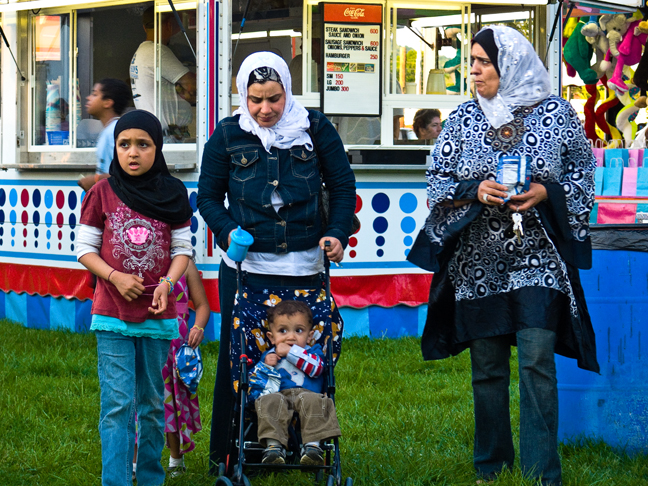
Most people lament that at least some aspects of physical reality prevent or inhibit freedoms in ways that are beyond control. Other living things, those that display some form of consciousness anyway, probably share that lament. But what seems peculiar to humans is that the ideas within our own heads also inhibit our freedoms, often in ways that are far harsher than anything Nature imposes. Consider the image above. The setting is America. But the women and children depicted are not from the U.S. They are visitors or immigrants. They look uncomfortably out of place. They also look worried, possibly even fearful. But of what are they afraid? They are at a carnival, a place of benign family amusement where almost everyone around them is wearing an expression of wonderment or glee. There is certainly no one hovering near them with club or whip. It seems unlikely physical reality is provoking their apprehension. So, what is? My best guess would be the ideas inside their heads. But what are those ideas? It's really hard to say without knowing them. But again, my best guess would be that they are experiencing some sort of apprehension brought on by dissonances between ideas they are familiar and comfortable with and ideas represented by all the unfamiliar goings on around them. Anyone who's had a similar experience of being an "outsider" can, I'm sure, sympathize. Ideas connect us to our environment. When our ideas fail to comfortably connect us to things, we become apprehensive, fearful. It is less the physical reality itself, but our inability to comprehend current reality's processes and relationships in a way that allows us to participate. A great many of us seldom venture outside our familiar comfort zone, where our ideas are well suited to the world we inhabit. Perhaps out of necessity, these folks have. But one can imagine that over time, these folks will eventually find comfortable connection to their new surroundings. A century ago in Chicago, Jane Addams and Ellen Gates Starr founded and developed what became known as Hull House to help recent immigrants accommodate to their new surroundings. Their work was a recognized success. The organization they started continues today. But we seldom hear of either their work or their successes. In fact, across the U.S. today there are relatively few places where the notion of community is high in the minds of people, where folks recognize commonality and seek to help and support one another. Rather, most of us seem preoccupied with notions of contrast that serve to divide our numbers into competing groups. It's a trend that measurably increases inefficiency and strife, and seems likely to hasten the collapse of global interdependence. Some would count the work of religious organization to be pro community. For the most part, I would not. I would not because most religions stress adherence to sets of ideas that divide our numbers into competing groups, instead of emphasizing human commonality and mutual dependence on the processes and bounties of nature. But on the other hand, many religious organizations do offer significant help to newcomers of similar faith in efforts to accommodate to new surroundings. Unfortunately, that effort very often serves to solidify a lasting separateness that can perpetuate discomfort, apprehension, and impoverished isolation. Again, the ideas we carry inside our heads likely will continue to inhibit the very real and practical freedoms we enjoy. It wouldn't hurt to reexamine some of those ideas now and again. Fresh ideas can be very invigorating. |
• Posted: Jun 14, 2010 11:29:24
• Comments Welcome
• Vote CoolPhotoblogs
• Purchase a Print
• Share
Wednesday, May 5th, 2010 Allentown PA USA |